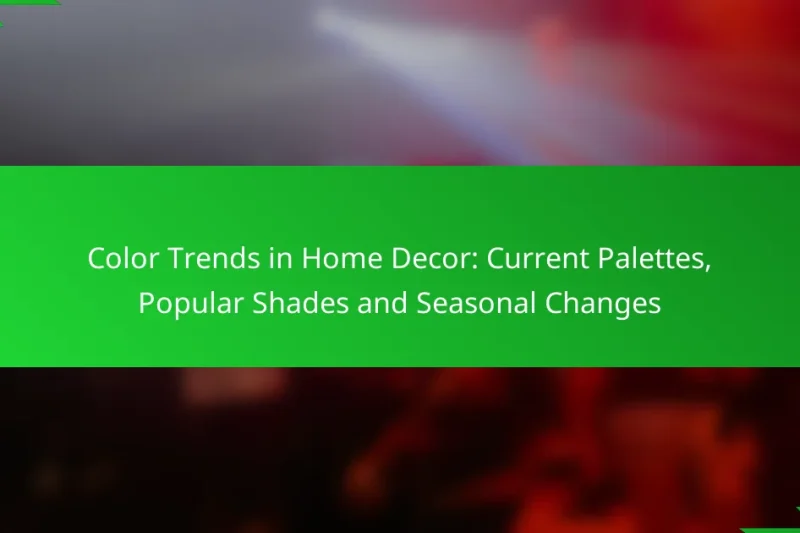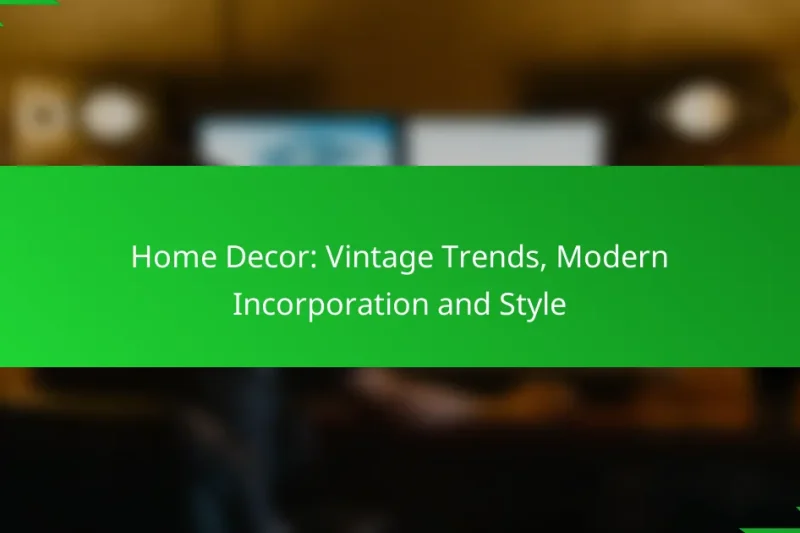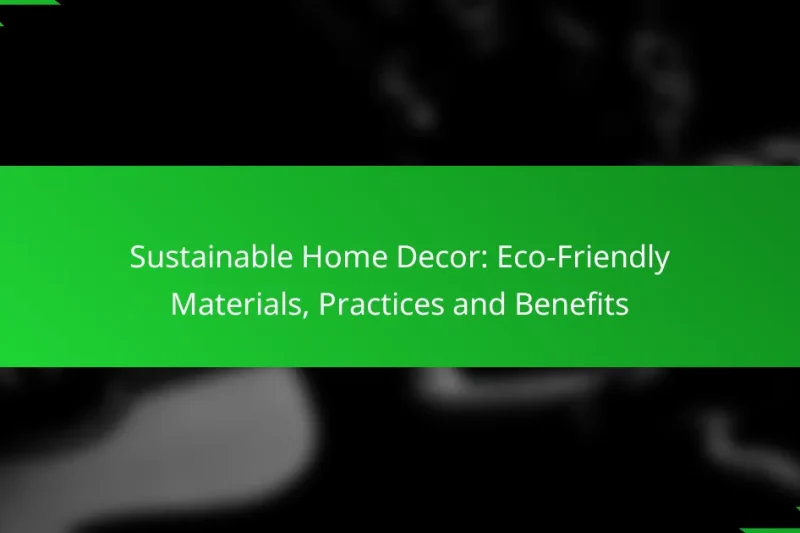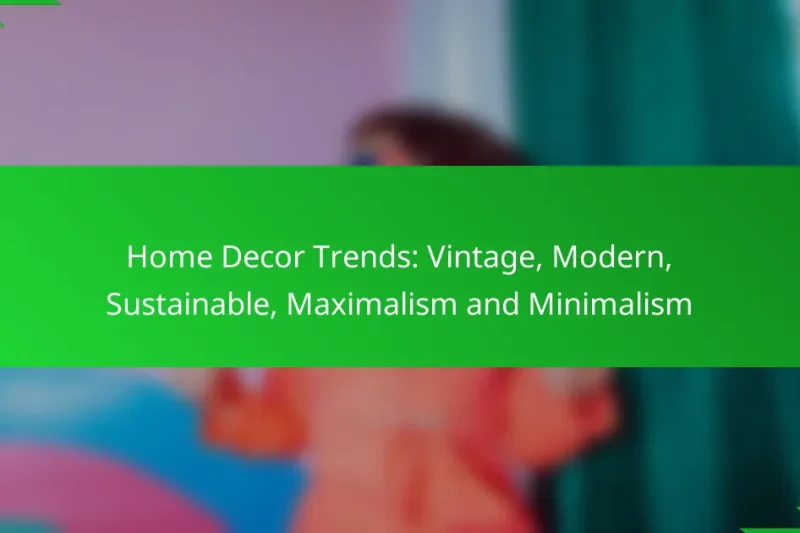Color trends in home decor are evolving to embrace a harmonious blend of neutral palettes and … Color Trends in Home Decor: Current Palettes, Popular Shades and Seasonal ChangesRead more
Current Home Decor Trends
As we explore the current home decor trends of 2023, the emphasis is on creating environments that enhance well-being and reflect personal style. Key themes include biophilic design, which connects interiors with nature, and maximalism, which celebrates vibrant colors and eclectic aesthetics. Earthy color palettes and multifunctional spaces further highlight the importance of comfort and practicality in modern living.
Home Decor Trends: Social Media Influence, Trends and Inspiration
Social media has become a pivotal force in shaping home decor trends, allowing users to find … Home Decor Trends: Social Media Influence, Trends and InspirationRead more
Home Decor: Vintage Trends, Modern Incorporation and Style
Embracing vintage decor trends in modern homes offers a unique opportunity to blend timeless charm with … Home Decor: Vintage Trends, Modern Incorporation and StyleRead more
Maximalism vs. Minimalism: Which Is Better and When to Use
Maximalism and minimalism are two contrasting design philosophies that cater to different needs and aesthetics. Maximalism … Maximalism vs. Minimalism: Which Is Better and When to UseRead more
Sustainable Home Decor: Eco-Friendly Materials, Practices and Benefits
Sustainable home decor emphasizes the use of eco-friendly materials and practices that reduce environmental impact while … Sustainable Home Decor: Eco-Friendly Materials, Practices and BenefitsRead more
Home Decor Trends: Vintage, Modern, Sustainable, Maximalism and Minimalism
In 2023, home decor trends are embracing a diverse mix of vintage charm, modern minimalism, and … Home Decor Trends: Vintage, Modern, Sustainable, Maximalism and MinimalismRead more
What are the top home decor trends in 2023?
The top home decor trends in 2023 focus on creating spaces that promote well-being, individuality, and functionality. Key trends include biophilic design, maximalism, earthy color palettes, vintage revival, and multifunctional spaces.
Biophilic design
Biophilic design emphasizes the connection between nature and interior spaces, incorporating natural elements to enhance well-being. This can include large windows for natural light, indoor plants, and water features. Consider using materials like wood and stone to create a calming environment that mimics outdoor settings.
To effectively implement biophilic design, aim for a balance of natural and artificial elements. Use greenery strategically, such as vertical gardens or potted plants, to improve air quality and aesthetics. Avoid overcrowding spaces with too many plants, which can lead to maintenance challenges.
Maximalism
Maximalism is characterized by bold colors, eclectic patterns, and a mix of textures, allowing for personal expression in home decor. This trend encourages layering different styles, from vintage to contemporary, creating a vibrant and personalized space. Think of combining various art pieces, textiles, and furniture styles to achieve a unique look.
When embracing maximalism, focus on creating focal points within a room. Use oversized artwork or statement furniture to draw attention, while ensuring that the overall design remains cohesive. Avoid overwhelming the space by limiting the number of competing patterns and colors.
Earthy color palettes
Earthy color palettes draw inspiration from nature, featuring warm tones like terracotta, olive green, and muted browns. These colors create a soothing atmosphere and can be easily incorporated through paint, furniture, or accessories. Consider using a combination of these shades to evoke a sense of tranquility and warmth in your home.
To effectively use earthy tones, pair them with natural materials such as wood and stone. This combination enhances the organic feel of the space. Avoid overly bright or harsh colors that can disrupt the calming effect of an earthy palette.
Vintage revival
The vintage revival trend celebrates retro styles from past decades, incorporating antique furniture and decor items into modern spaces. This trend allows for creativity and nostalgia, as homeowners mix old and new elements. Look for unique pieces at thrift stores or flea markets to add character to your home.
When integrating vintage items, ensure they complement your existing decor. Use a few statement pieces, such as a mid-century chair or a vintage lamp, to create a focal point. Avoid cluttering the space with too many vintage items, which can detract from their charm.
Multifunctional spaces
Multifunctional spaces are designed to serve multiple purposes, maximizing the use of limited square footage. This trend is particularly relevant in urban settings where space is at a premium. Consider using furniture that can easily transform, such as a sofa bed or a dining table that doubles as a workspace.
To create effective multifunctional spaces, prioritize flexibility and organization. Use storage solutions like ottomans or built-in shelves to keep the area tidy. Avoid rigid layouts that limit the functionality of the space, allowing for adaptability as needs change.
How can I incorporate biophilic design into my home?
Incorporating biophilic design into your home involves integrating natural elements to create a connection with nature. This can be achieved through the use of indoor plants, natural materials, and maximizing natural light.
Use indoor plants
Indoor plants are a fundamental aspect of biophilic design, as they enhance air quality and bring a sense of tranquility. Consider using a variety of plants, such as ferns, succulents, and snake plants, which are generally easy to care for and thrive indoors.
When selecting plants, aim for a mix of sizes and textures to create visual interest. Place larger plants in corners or near windows, while smaller ones can adorn shelves or tables. Regular maintenance, such as watering and pruning, will keep your indoor garden vibrant.
Natural materials
Using natural materials like wood, stone, and bamboo can significantly enhance the biophilic feel of your home. These materials not only add warmth and texture but also create a more organic atmosphere.
Incorporate wooden furniture, stone countertops, or bamboo flooring to establish a connection with nature. When choosing materials, look for sustainably sourced options to minimize environmental impact and consider finishes that highlight the natural beauty of the materials.
Large windows for natural light
Maximizing natural light through large windows is essential in biophilic design, as it connects indoor spaces with the outdoors. Consider installing floor-to-ceiling windows or expansive sliding doors that open to gardens or patios.
When designing your space, orient windows to capture sunlight throughout the day. Use sheer curtains or blinds to control light without obstructing views. This approach not only brightens your home but also improves mood and well-being by allowing you to enjoy the changing light and scenery outside.
What are the benefits of maximalism in home decor?
Maximalism in home decor promotes a vibrant and eclectic aesthetic that encourages personal expression and creativity. By embracing bold patterns, colors, and a variety of textures, maximalism allows individuals to create unique spaces that reflect their personality and experiences.
Personal expression
Maximalism offers a platform for personal expression by allowing homeowners to showcase their interests and tastes through decor. This style encourages the use of diverse items, such as art pieces, collectibles, and family heirlooms, creating a narrative that is distinctly personal. Each element can tell a story, making the space feel more intimate and inviting.
To effectively express yourself through maximalism, consider curating items that resonate with you. Aim for a mix of vintage and contemporary pieces to create a dynamic visual experience. Remember, the goal is to reflect who you are, so choose items that spark joy and conversation.
Layered textures
Layered textures are a hallmark of maximalism, adding depth and interest to any room. This approach involves combining various materials such as wood, fabric, metal, and glass to create a rich sensory experience. For instance, pairing a plush velvet sofa with a woven rug and metallic accents can enhance the overall aesthetic.
When layering textures, think about balance and harmony. Use a variety of fabrics, such as cotton, linen, and leather, to create contrast while ensuring that the colors complement each other. This technique not only adds visual appeal but also invites tactile interaction, making spaces feel more inviting.
Bold color combinations
Bold color combinations are essential in maximalist decor, allowing for striking visual impact. This style encourages the use of vibrant hues and unexpected pairings, such as deep blues with bright yellows or rich greens with warm reds. The key is to create a cohesive look despite the variety of colors.
To successfully implement bold colors, consider using a color wheel for inspiration. Choose a primary color and select complementary or analogous colors to enhance the palette. Don’t shy away from experimenting; sometimes, the most unexpected combinations can yield the most stunning results. Just ensure that the colors harmonize to avoid overwhelming the space.
Which earthy color palettes are trending?
Earthy color palettes are gaining popularity in home decor, emphasizing natural tones that create a warm and inviting atmosphere. These palettes often include warm neutrals, muted greens, and terracotta tones, each contributing to a serene and grounded aesthetic.
Warm neutrals
Warm neutrals, such as beige, taupe, and soft browns, are versatile choices that can complement various design styles. These colors work well in living spaces, providing a cozy backdrop for furniture and decor. Consider using warm neutrals on walls or larger furniture pieces to create a harmonious environment.
When selecting warm neutrals, aim for shades that reflect the natural light in your home. Test samples in different lighting conditions to see how they change throughout the day. Pair these tones with textured fabrics and natural materials for added depth.
Muted greens
Muted greens, including sage and olive, evoke a sense of tranquility and connection to nature. These shades can be used to create a calming atmosphere in bedrooms or home offices. Incorporating muted greens through paint, upholstery, or decorative accents can enhance the overall aesthetic.
To effectively use muted greens, consider combining them with other earthy tones or warm neutrals. This creates a balanced look that feels cohesive. Plants and natural wood elements can further enhance the green palette, bringing the outdoors inside.
Terracotta tones
Terracotta tones, ranging from soft clay to deep rust, add warmth and character to any space. These colors are particularly effective in kitchens and dining areas, where they can create a welcoming ambiance. Terracotta can be introduced through wall paint, pottery, or decorative tiles.
When using terracotta tones, balance them with lighter shades to avoid overwhelming the space. Pairing terracotta with greens or warm neutrals can create a stunning contrast that feels both inviting and stylish. Consider using terracotta in accent pieces to draw attention without dominating the room.
How to choose vintage decor pieces?
Choosing vintage decor pieces involves understanding your style preferences and knowing where to find authentic items. Look for pieces that resonate with your aesthetic while also considering their condition and historical significance.
Visit local thrift stores
Local thrift stores are treasure troves for vintage decor. They often carry a wide range of items, from furniture to decorative accents, at affordable prices. Regular visits can help you spot unique finds, as inventory changes frequently.
When shopping, inspect items for quality and potential repairs. Look for solid wood furniture or well-made textiles, as these tend to be more durable and valuable over time.
Online marketplaces like Etsy
Online marketplaces such as Etsy provide access to a vast selection of vintage decor from various sellers. You can find everything from handmade items to curated collections, often with detailed descriptions and seller ratings.
When purchasing online, pay attention to shipping costs and return policies. It’s wise to read reviews and ask sellers questions to ensure the authenticity and condition of the pieces you are considering.
Attend estate sales
Estate sales can be excellent opportunities to find high-quality vintage decor. These sales often feature items from homes that are being sold, providing a glimpse into different eras and styles.
Arrive early to get the best selection and be prepared to negotiate prices. Bring cash, as some estate sales may not accept cards, and consider taking measurements to ensure larger items fit your space.
What are the best multifunctional furniture options?
Multifunctional furniture options are versatile pieces that serve multiple purposes, making them ideal for maximizing space in homes. Popular choices include sofa beds, storage ottomans, and extendable dining tables, which cater to various needs without sacrificing style.
Sofa Beds
Sofa beds are a classic choice for multifunctional furniture, providing both seating and sleeping space. They are particularly useful in small apartments or guest rooms, where accommodating visitors is essential. When selecting a sofa bed, consider the ease of conversion and the comfort of the mattress.
Storage Ottomans
Storage ottomans combine functionality with aesthetics, serving as both footrests and hidden storage solutions. They can hold blankets, magazines, or toys, helping to keep living spaces organized. Look for ottomans with removable tops for easy access and consider materials that match your decor.
Extendable Dining Tables
Extendable dining tables are perfect for those who host gatherings but have limited space. These tables can be adjusted to accommodate more guests when needed and compacted when not in use. When choosing an extendable table, check the mechanism for ease of use and the materials for durability.





